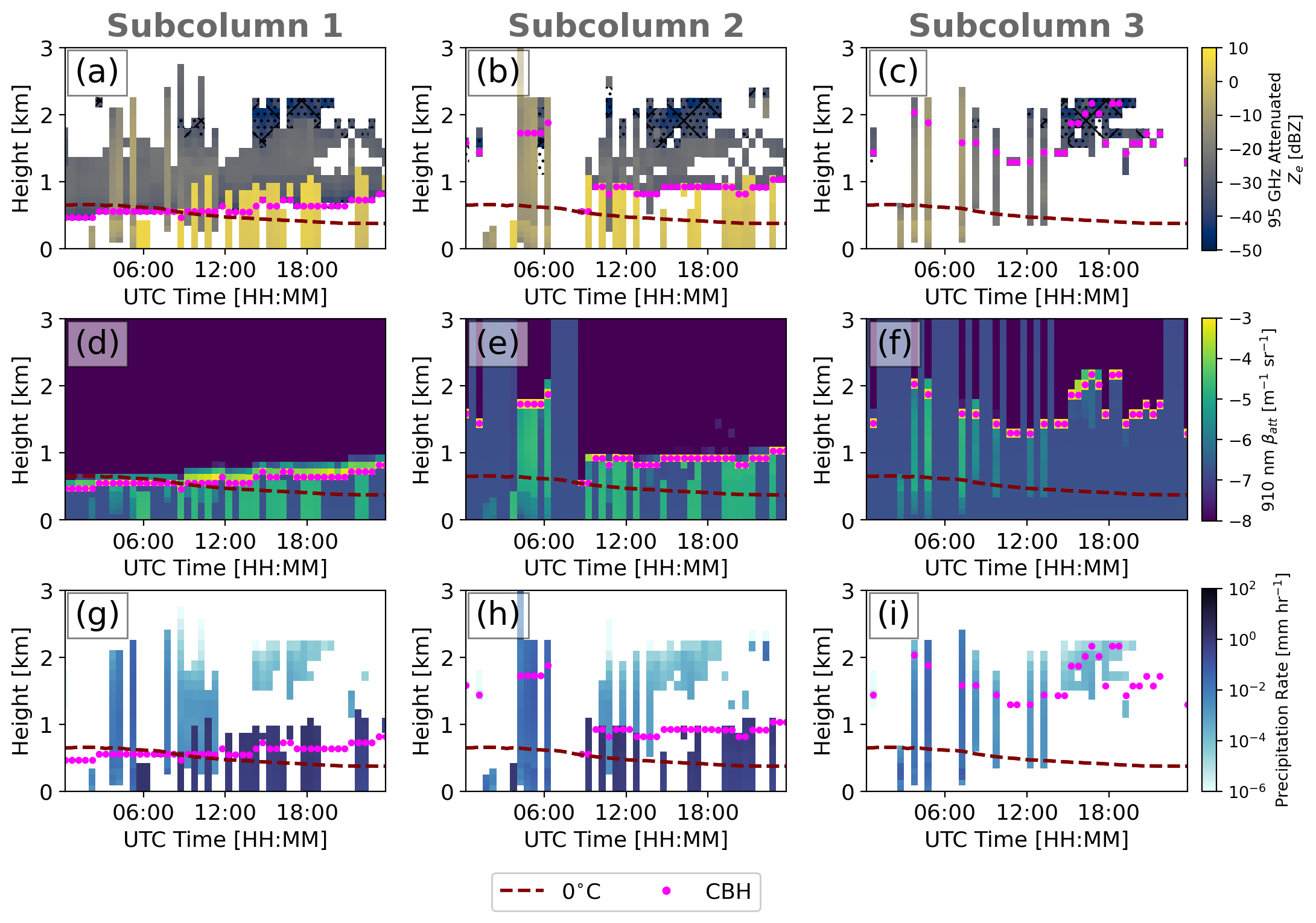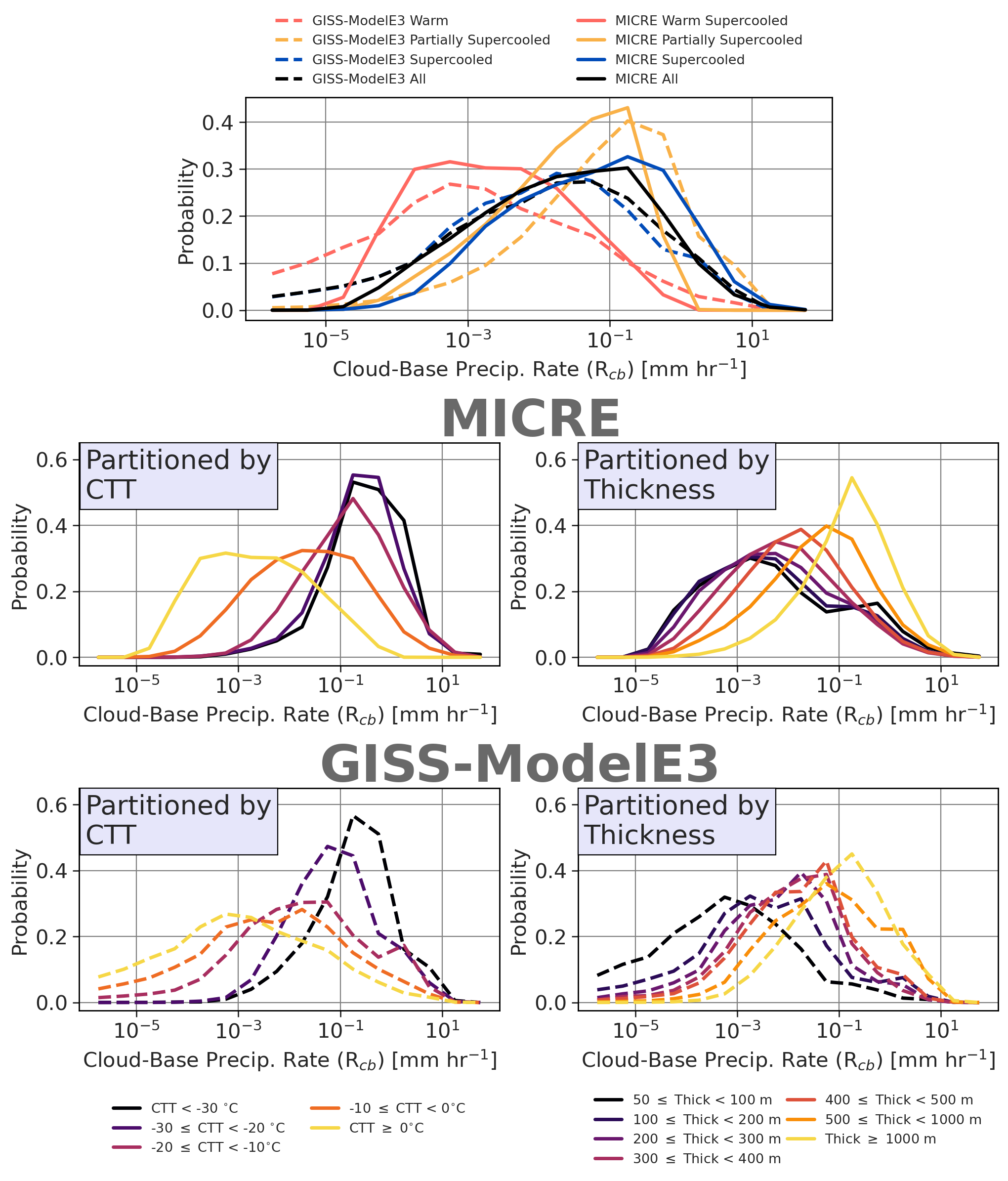Evaluating precipitation occurrence in the NASA-GISS ModelE3 ESM against MICRE observations
Submitter
Stanford, McKenna — Columbia University
Fridlind, Ann M.
— Goddard Institute for Space Studies
Area of Research
Cloud-Aerosol-Precipitation Interactions
Journal Reference
Stanford M, A Fridlind, I Silber, A Ackerman, G Cesana, J Mülmenstädt, A Protat, S Alexander, and A McDonald. 2023. "Earth-system-model evaluation of cloud and precipitation occurrence for supercooled and warm clouds over the Southern Ocean's Macquarie Island." Atmospheric Chemistry and Physics, 23(16), 10.5194/acp-23-9037-2023.
Science

Figure 1. Example 24 h time–height series of EMC2 -simulated (a)–(c) 95 GHz attenuated radar reflectivity (Ze), (d)–(e) 910 nm attenuated backscatter (βatt), and (g)–(i) GISS-ModelE3 precipitation rate for a slightly supercooled, intermittently precipitating stratocumulus case. The three columns represent three out of eight subcolumns generated using EMC2. From journal.

Figure 2. Cloud-base precipitation rate (Rcb) distributions for MICRE observations (solid lines) and the GISS-ModelE3 ESM simulation (dotted lines), partitioned by (a) cloud layer supercooling (b,c) cloud top temperature, and (d,e) cloud geometric thickness. From journal.
Precipitation is the primary sink of cloud condensate in the extratropics, but quantifying the frequency at which clouds precipitate in both models and observations is challenged by differences in space- versus land-based observing platforms, instrument sensitivity, detection algorithms, and model-observation comparison methodologies. A year of profiling instrumentation from the ARM Macquarie Island Cloud and Radiation Experiment (MICRE) was used to evaluate the occurrence frequency of cloud-base precipitation in the NASA GISS-ModelE3 Earth system model (ESM) by employing a uniquely constrained approach by which ESM output is processed through a radar/lidar instrument simulator with the same specifications as MICRE instrumentation.
Impact
Liquid-based clouds over Macquarie Island precipitate from cloud base ~70% of the time, while the ESM underpredicted this frequency by 10-15 % for both supercooled- and warm-based clouds. Such low-biased precipitation occurrence frequency over the Southern Ocean (SO) contrasts with numerous studies that suggest a propensity for SO clouds to precipitate too frequently in ESMs, a finding that may be due to different sampling methodologies for ground- versus space-based observations, motivating future work to compare ESM frequencies with both data sources in an integrated framework.
Summary
We evaluated the frequency of cloud-base precipitation (independent of whether it reaches the surface) in a 9-year global, free-running simulation of the NASA GISS-ModelE3 ESM against a year of MICRE profiling observations (radar, ceilometer, and soundings). Time-step column output at Macquarie Island’s geographic location was processed through the Earth Model Column Collaboratory (EMC2; Silber et al. 2022) radar and lidar instrument simulator and subcolumn generator (Figure 1), providing a uniquely constrained comparison methodology. The ESM produced lower cloud and precipitation occurrence frequencies relative to MICRE with little interannual variability. Despite this, the ESM correctly reproduced the observed finding that precipitation rates increase with increasing cloud geometric thickness and decreasing cloud top temperature (Figure 2). The model also produced near-surface clouds and fog that accounted for ~ 25 % of liquid cloud bases during MICRE, as well as optically thin, non-precipitating clouds that accounted for ~ 27 % of clouds with bases higher than 250 m. Future work should focus on determining the extent to which spaceborne platforms are yielding low precipitation occurrence frequencies relative to ground-based instrumentation across the entire SO latitude band and performing similar evaluations in other ESMs to determine if the finding here is unique to ModelE3.
Keep up with the Atmospheric Observer
Updates on ARM news, events, and opportunities delivered to your inbox
ARM User Profile
ARM welcomes users from all institutions and nations. A free ARM user account is needed to access ARM data.


















